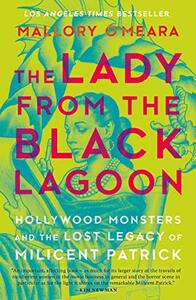Take a photo of a barcode or cover
837 reviews for:
The Lady from the Black Lagoon: Hollywood Monsters and the Lost Legacy of Milicent Patrick
Mallory O'Meara
837 reviews for:
The Lady from the Black Lagoon: Hollywood Monsters and the Lost Legacy of Milicent Patrick
Mallory O'Meara
Reads more like a blog post than book. But fascinating subject!
Idk if I've ever quite read a nonfiction like this, in that the author has such a personal connection to the subject of the biography and really hits home how relevant this story is to today. Milicent Patrick was, among many things, a professional creative in Hollywood who put up with a lot of sexist bullshit, and O'Meara, as a horror movie producer, can fucking relate. The areas where this book shines: the impeccable (and sometimes impossible) research, passionately discussing horror and monsters, and humanizing Patrick - O'Meara really brings her to life. There are some spots where it's clear O'Meara doesn't have tons of experience honing the craft of writing, she goes on a few rants that could've been tightened up and it felt like they were partially there to fill some space where the data on Patrick was lacking; also, O'Meara in some spots expertly weaves relevant, modern, personal experience into the themes of Patrick's life, but sometimes this personal writing falls a little short, isn't fully fleshed out enough to feel like it belongs in the story (if the book is about the author and the subject, I want the author to really dig in, I want 2 character arcs, I want the author to learn something about themselves. An example from the book where this is done very well is when O'Meara talks about her initial anger at Milicent for not setting the world on fire after she's dismissed from Universal).
Also, I usually fucking hate the device of footnotes for jokes in nonfiction, but O'Meara pulled this off so effectively (maybe because usually I come across this trope in humorous nonfiction and putting ranting asides in the footnotes feels like a crutch, whereas O'Meara uses her footnotes mostly for a little comedic relief/authorial editorialising). I can't pick a favourite but one that really stuck with me was O'Meara making mention of a man who was the kind to lament the "good old days" and attached a footnote to this to let the readers know she was making the jack off hand motion. I lol'd.
Also, I usually fucking hate the device of footnotes for jokes in nonfiction, but O'Meara pulled this off so effectively (maybe because usually I come across this trope in humorous nonfiction and putting ranting asides in the footnotes feels like a crutch, whereas O'Meara uses her footnotes mostly for a little comedic relief/authorial editorialising). I can't pick a favourite but one that really stuck with me was O'Meara making mention of a man who was the kind to lament the "good old days" and attached a footnote to this to let the readers know she was making the jack off hand motion. I lol'd.
Being a fan of Mallory on her podcast, Reading Glasses, I wanted to read this to support her, but put it off for a year due to the assumption that it just wouldn't be that interesting to me since I'm not into creating monsters or horror movies. However, I was pleasantly surprised that I was wrong.
Lady From the Black Lagoon is about Milicent Patrick who created the suit for the Creature From the Black Lagoon never receiving credit for it in the movie. Not only was it about her, but about Mallory O'Meara herself and her struggles as a female in a still male dominated business in regards to her producer aspirations.
Even though it didn't make me want to run out and watch Creature From the Black Lagoon, it was still interesting hearing how O'Meara was able to eventually uncover so much about Patrick and empathize with both of their stories trying to advance in their careers honestly and not judged solely as a woman.
Lady From the Black Lagoon is about Milicent Patrick who created the suit for the Creature From the Black Lagoon never receiving credit for it in the movie. Not only was it about her, but about Mallory O'Meara herself and her struggles as a female in a still male dominated business in regards to her producer aspirations.
Even though it didn't make me want to run out and watch Creature From the Black Lagoon, it was still interesting hearing how O'Meara was able to eventually uncover so much about Patrick and empathize with both of their stories trying to advance in their careers honestly and not judged solely as a woman.
An excellent read, but my favorite part is how the author ties in her research journey and her own experiences in the film industry to this story, making it an atypical and creative biography.
Great info and research!! So thankful that this exists!!
What a whirlwind. The Lady from the Black Lagoon is an investigative journey that I was glad to be swept up in.
The book is, at its core, about the life of Milicent Patrick, one of Disney’s first female animators and the designer behind one of films greatest characters, and the mystery surrounding her life when she disappeared after The Creature from the Black Lagoon’s success. However, that’s not all the book is about. It’s also about the toxic male dominate culture of Hollywood, past, and present, and the difficulties women have trying to succeed in these environments when faced with rampant sexism. Milicent Patrick never got the recognition she deserved for her work on The Creature and various other films that she worked on. She was a talented and dedicated artist whose career was cut short when an irrational and jealous colleague couldn’t stand to see her being successful.
The book is also about Mallory O’Meara’s own journey of learning more about Milicent Patrick’s life, filling in all the blanks, of which there are many of. As Mallory O’Meara discovers early on there isn’t a lot of information about Milicent’s life. O’Meara’s never-ending enthusiasm about discovering new details of the subject’s life is a joy to read. I believe the structure of the book makes sense to this investigation. It’s like the readers are along for the ride. Just as the author is finding these details, readers are anxiously awaiting them too.
This book does contain a lot of information about the entertainment industry and in particular the studios surrounding Old Hollywood. Sometimes the information about the film and entertainment industry can a feel a little…. Pointless, especially in the second half. That couldn’t have been because I was so interested in learning the next part of Milicent’s life. I understand that it helped set the scene of Milicent’s life but it wasn’t something I was too interested in.
It was really interesting to learn about how many remarkable women Milicent came into contact with. Women like Nerbert Chounaird and Julia Morgan, were such pioneers and strong members of their community. It seems fitting that Milicent was as well.
One of my favorite things about this book is that it paints Milicent as a normal woman. The persona that she created was this glamorous woman, and she most definitely was, but she was still just a woman. As the author states she was, “simply intelligent and save and good at what she did.” “We need women to be allowed to be simply good at what they do.” I love how Mallory admits that her initial idea of Milicent Patrick was flawed and based on her own thinking. Of course, Milicent was an interesting person but she was very human. She experienced her ups and downs too. That’s what Makes Milicent so inspiring.
I certainly do not doubt that Mallory O’Meara was destined to write this book and tell Milicent’s story.
The book is, at its core, about the life of Milicent Patrick, one of Disney’s first female animators and the designer behind one of films greatest characters, and the mystery surrounding her life when she disappeared after The Creature from the Black Lagoon’s success. However, that’s not all the book is about. It’s also about the toxic male dominate culture of Hollywood, past, and present, and the difficulties women have trying to succeed in these environments when faced with rampant sexism. Milicent Patrick never got the recognition she deserved for her work on The Creature and various other films that she worked on. She was a talented and dedicated artist whose career was cut short when an irrational and jealous colleague couldn’t stand to see her being successful.
The book is also about Mallory O’Meara’s own journey of learning more about Milicent Patrick’s life, filling in all the blanks, of which there are many of. As Mallory O’Meara discovers early on there isn’t a lot of information about Milicent’s life. O’Meara’s never-ending enthusiasm about discovering new details of the subject’s life is a joy to read. I believe the structure of the book makes sense to this investigation. It’s like the readers are along for the ride. Just as the author is finding these details, readers are anxiously awaiting them too.
This book does contain a lot of information about the entertainment industry and in particular the studios surrounding Old Hollywood. Sometimes the information about the film and entertainment industry can a feel a little…. Pointless, especially in the second half. That couldn’t have been because I was so interested in learning the next part of Milicent’s life. I understand that it helped set the scene of Milicent’s life but it wasn’t something I was too interested in.
It was really interesting to learn about how many remarkable women Milicent came into contact with. Women like Nerbert Chounaird and Julia Morgan, were such pioneers and strong members of their community. It seems fitting that Milicent was as well.
One of my favorite things about this book is that it paints Milicent as a normal woman. The persona that she created was this glamorous woman, and she most definitely was, but she was still just a woman. As the author states she was, “simply intelligent and save and good at what she did.” “We need women to be allowed to be simply good at what they do.” I love how Mallory admits that her initial idea of Milicent Patrick was flawed and based on her own thinking. Of course, Milicent was an interesting person but she was very human. She experienced her ups and downs too. That’s what Makes Milicent so inspiring.
I certainly do not doubt that Mallory O’Meara was destined to write this book and tell Milicent’s story.
Listened on audio.
The book is less about Millicent Patrick and more about the author's experiences in the film industry and her opinions about sexism and privilege.
She does a good job of calling out the many types of privilege that exist, but ultimately it feels like O'Meara realized the info on Patrick she had was not enough for a full book, so she went back in and pumped in commentary, anecdotes and stories from her own life.
The book is less about Millicent Patrick and more about the author's experiences in the film industry and her opinions about sexism and privilege.
She does a good job of calling out the many types of privilege that exist, but ultimately it feels like O'Meara realized the info on Patrick she had was not enough for a full book, so she went back in and pumped in commentary, anecdotes and stories from her own life.
emotional
hopeful
informative
medium-paced
I really wanted to like this book. The story of Milicent Patrick the designer of the Creature from the Black Lagoon is absolutely fascinating. Unfortunately the writing style did not really work for me. There are a lot of asides or breathless foreshadowing that makes this seem like a bunch of blog posts rather than a book. The amount of research that the author did and the story she has uncovered is impressive, but this book felt like it needed stronger editorial intervention. Her account of going on a research trip is peppered full of asides about how she made her sick friend go with her even though he was supposed to be studying for his nursing exam and how she listens to too many true crime podcasts. These asides really detracted from the main point of the chapter.
My problems with the book are mostly twofold: First, O'Meara seems intent on taking Patrick's very particular story and universalizing it for the Me Too era. Even though Patrick does not report any sexual harassment, her career in Hollywood was very gendered. However O'Meara does not present any evidence that Patrick thought about the discrimination that she received in these terms. Putting contemporary interests and concerns on one woman's very unusual and very interesting career (from Disney animator to bit player to makeup designer to society wife) seemed to be doing Patrick and the writer's own research a great disservice. Millicent Patrick seemed less interested in shattering glass ceilings than finding routes around them and having a career on her own terms. It makes her a slippery and enigmatic figure but not a Joan of Arc. O'Meara's equation of Patrick's marginalization with the very real abuse suffered by women in Hollywood today doesn't allow Patrick to speak for herself as an individual historical figure (the point of a biography). Rather it makes her a stand-in for all women in Hollywood and I am not convinced that this is what she is. Had she lived she might have seen herself as a member of the Me Too movement, but as she never left written record, we will probably never know and probably shouldn't assume that we can make this determination for her. We don't know her and neither does O'Meara.
Second, as another reviewer mentioned above, O'Meara often castigates Patrick's male colleagues for objectifying her or dwelling only on her physical appearance. Yet she herself does the same thing. She repeatedly uses the word "stunning" to describe Patrick at every turn. This kind of goes back to my original point that this book needed a better editor, because she could have varied the word choice a bit, but it also has the unintended consequence of suggesting that Milicent Patrick is interesting not because of her accomplishments or her life but because she did so while also looking like "a goth Jessica Rabbit."
I ended up finishing this book because I really wanted to know what happened to Milicent Patrick, but I wish the execution of this book was better than it was.
My problems with the book are mostly twofold: First, O'Meara seems intent on taking Patrick's very particular story and universalizing it for the Me Too era. Even though Patrick does not report any sexual harassment, her career in Hollywood was very gendered. However O'Meara does not present any evidence that Patrick thought about the discrimination that she received in these terms. Putting contemporary interests and concerns on one woman's very unusual and very interesting career (from Disney animator to bit player to makeup designer to society wife) seemed to be doing Patrick and the writer's own research a great disservice. Millicent Patrick seemed less interested in shattering glass ceilings than finding routes around them and having a career on her own terms. It makes her a slippery and enigmatic figure but not a Joan of Arc. O'Meara's equation of Patrick's marginalization with the very real abuse suffered by women in Hollywood today doesn't allow Patrick to speak for herself as an individual historical figure (the point of a biography). Rather it makes her a stand-in for all women in Hollywood and I am not convinced that this is what she is. Had she lived she might have seen herself as a member of the Me Too movement, but as she never left written record, we will probably never know and probably shouldn't assume that we can make this determination for her. We don't know her and neither does O'Meara.
Second, as another reviewer mentioned above, O'Meara often castigates Patrick's male colleagues for objectifying her or dwelling only on her physical appearance. Yet she herself does the same thing. She repeatedly uses the word "stunning" to describe Patrick at every turn. This kind of goes back to my original point that this book needed a better editor, because she could have varied the word choice a bit, but it also has the unintended consequence of suggesting that Milicent Patrick is interesting not because of her accomplishments or her life but because she did so while also looking like "a goth Jessica Rabbit."
I ended up finishing this book because I really wanted to know what happened to Milicent Patrick, but I wish the execution of this book was better than it was.
challenging
informative
slow-paced







